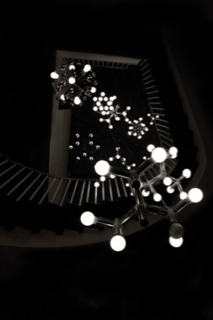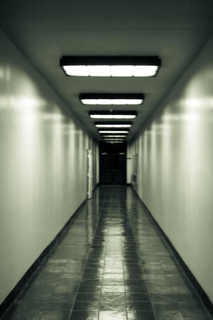Inspiring Interior Design (Part 13)
By Asher Crispe: August 22, 2012: Category Inspirations, Quilt of Translations
Psycho-Spiritual Luminescence
 In our assessment of the total lighting requirements of the home can be pushed even further. We can come to think of it as alternating bands of light and shadow constituting a kind of ‘barcode’ for identifying all of the aspects of human consciousness (with 8 stripes in all). If we itemize each of these bands respectively, all of the inner powers of the soul work their way into our thinking through the metaphor of interior lighting design.
In our assessment of the total lighting requirements of the home can be pushed even further. We can come to think of it as alternating bands of light and shadow constituting a kind of ‘barcode’ for identifying all of the aspects of human consciousness (with 8 stripes in all). If we itemize each of these bands respectively, all of the inner powers of the soul work their way into our thinking through the metaphor of interior lighting design.
The very first appearance of darkness (the darkness that comes before light) relates to the most remote recesses of our superconscious crown (keter). While the superconscious as a whole is taken to be ‘dark’ in comparison to the remainder of the powers of the soul which are deemed to be conscious and therefore connected to light, it nevertheless has its own reiteration of light and dark. This is because the superconscious, when investigated at higher resolution, actually contains three different experiential textures: that of faith, pleasure and will (emunah, ta’anug and ratzon). These serve as the motivators behind or before cognition, emotion and behavior. One has gone completely dark (the black ops of faith), while the other two (pleasure and will) emit detectible radiation as ultra low-key ambient lighting within the soul.
Relatively speaking, ‘faith’ is characteristic of a total ‘blackout’ of consciousness, the shadow within the shadow, or the ensconced reservoir of spiritual riches. As the concealed residence of our ‘quintessential inner strength’ (chevion ohz atzmuto in the language of the Arizal), faith allows a person to connect to the unknown and the unknowable. In the Genesis text (1:2), this corresponds to the first appearance of ‘darkness,’ the most primordial darkness in the soul: “…and darkness was upon the face of the abyss.”
Imagine dropping a stone into a special well with a great yawning mouth that opens into an unfathomable darkness below, whereupon it falls and falls forever without making a sound. This well or chasm is bottomless. The stone has nowhere to splashdown. Our probe is lost in this unimaginable expanse never to be recovered. These descriptions touch upon the core of our being–the infinite hidden in the ‘vaulted ceiling’ of our soul. This sense can be reproduced in the remote spaces of the room which escape illumination. Where the outline gets lost in the shadows, we might contemplate if space itself vanishes as our eyes drink from the abyss. Every room requires a hiding place which is a ‘hiding’ of place, a device of wonder and a ‘perception’ of faith.
Pleasure, the next aspect of the superconscious crown, is less remote. It shows itself in the light of serenity which we ‘de-light’ in. This association of pleasure and light stems from a verse in Psalms (36:10): “For with You is the origin of life; in Your light we see light.” The “source” or “origin” of life is interpreted as the “pleasure” in life or the origin of pleasure. To have an experience of ‘the source,’ the marrow of life, is to encounter sublime super-rational pleasure.
‘Pleasure’ does not happen alone but rather rapidly oscillates like a binary star system orbiting along with ‘will’ around a common object of ‘desire.’ Sometimes I want something because I find it pleasurable, and other times I find something pleasurable because I want it. Pleasure is expressed within the self, while will extends to the outside. Thus, we have interplay between this dynamic duo with one lamp shining within its container while the other disseminates its light according to its intentionality.
Some lights primarily illuminate the area within the light fixture–like an electric filament in a glass bulb which rests in a crystal base, sparkling as the index of refraction bounces its rays back and forth within itself in total internal reflection. This is an expression of pleasure that lights up my life. By contrast, our faculty of will requires a parabolic mirror in order to concentrate the emitted light on our intended object of focus. The lighting arrangements of pleasure and will entail injection and projection.
In ‘light’ of this, we should point out that the first time ‘light’ is mentioned in the Torah (Genesis 1:3), it appears as a pair: “God said: ‘Let there be light.’ And there was light.”
The Divine utterance can be seen as ‘God saying’ within Himself. After all, there is no other to hear Him. When He speaks it is illuminating between Him and Himself. Like a person who declares a preference for things to be a certain way that would be pleasurable to him or her but then holds it in, keeping the declaration to him- or herself. “And there was light” suggests the materialization of the first utterance. What is most important is that it be out “there” (“And there was light”) as an externalization, a shining forth or a standing out (to ex-ist).
What comes next is the first conscious level of catching sight of the light: “And God saw the light, that it was good.” (Genesis 1:4). ‘Seeing,’ in Kabbalah, relates to the faculty of wisdom and insight known as chochmah. As the ‘beginning of revelation’ chochmah intuits the essence of something (such as the ‘seeing’ of the light) but then needs to package it, to contextualize it in a framework of understanding (binah).
The ‘parent’ companies that run all our mental abilities are ‘wisdom’ and ‘understanding’ (chochmah and binah). To just catch hold of the seed potential (the mentality of ‘father’ according to the Zohar) of the light comes from its initial viewing (“and God saw the light”) while the recourse to adjectives and qualitative labels (“that it was good”) invites comparison to its comprehension (the mentality of ‘mother’). To stow or store away an insight within a preconceived framework of understanding challenges the mind to function according to the customs of ‘speed dating.’ An idea must find a matching predicate. It needs to quickly be tagged and filed within the greater matrix (mother) of our mind.
Thus, these next two levels of light which dramatize the workings of the mind must be the first visible light, the first thing to attract my eye when I enter the room and which I will later rate as a good quality of light. If you are out shopping for a lamp like this, then it needs to be both an attention grabber and leave a person with a strong conviction that it gives off good quality illumination. Representative of the cognitive dyad of wisdom and understanding, this light must work to help the viewer ‘make sense’ of the room. These are the ‘smart’ lights that radiate intelligence and intelligibility.
For our next pairing, we turn to the continuation in Genesis (1:4), where “…God divided the light from the darkness.” This power of differentiation is rooted in consciousness (da’at) as the offspring of our thought processes. We sense that our knowledge (da’at) may be taken in one of two ways: either it can develop into ‘dark’ emotional states or ‘light’ emotional states. Since all emotion is really only modifications of the two basic tendencies of love and fear, it follows that separating them from one another (just like the prohibition of eating milk [love] and meat [fear] together), will be the basic task of clarifying our emotions.
This duel band of light and dark has to be incandescent. Emotional lighting brings warmth to the room and is generated with heat. Nothing like a candlelit dinner to set the mood. Despite the technological datedness of the fireplace, we cannot seem to give it up. To kindle a fire in the room creates atmosphere and intimacy. Likewise, the (sudden) loss of light, ominous shadows or inky gloom, transports us onto a Hollywood film noir set. Dark equates with fear. Fear is fear of the unknown–of being kept in the dark. Therefore, the intensity of light and shadow factor in the palpable density of love and fear in our private interiors.
“And God called the light Day…” (Genesis 1:5) relates not to the conscious origin of the emotions, but rather to the expression of the emotions themselves. If light is the soul, then day represents the body. Day incorporates light. It contains it. The basic emotive impulses need to be incorporated as well. Embodying them may be likened to coloring the light of conscious. Light can be colored and it can also color the room. This light is iridescent. When viewed from different angles, it changes colors. Is that not exactly what emotion does? When I look upon my thoughts obliquely, they mutate and take on new characteristics. These lights can either color the room or enhance the colors of the room adding to the overall emotional charge.
 Finally, “and the darkness He called night” (Genesis 1:5) once again sets up the relationship of darkness as the soul and night as the body. This third type of darkness (the other two were ‘faith’ and ‘fear’) relates to the impression that my self-expression makes upon the world. To leave one’s mark amounts to a silhouette or a photographic negative. As an agent acting in the room, ‘I’ may cast a huge shadow. My actions can impact a region of space much larger than myself. But it is only pantomime. You don’t get ‘me’, you only get my afterimage sunken in or traced upon the objects that I interacted with. My works, my self-expression, may tarry or linger in my withdrawn absence. For instance, my words my live on without me. Conversation had hours ago may yet be faintly echoing throughout the room undetected.
Finally, “and the darkness He called night” (Genesis 1:5) once again sets up the relationship of darkness as the soul and night as the body. This third type of darkness (the other two were ‘faith’ and ‘fear’) relates to the impression that my self-expression makes upon the world. To leave one’s mark amounts to a silhouette or a photographic negative. As an agent acting in the room, ‘I’ may cast a huge shadow. My actions can impact a region of space much larger than myself. But it is only pantomime. You don’t get ‘me’, you only get my afterimage sunken in or traced upon the objects that I interacted with. My works, my self-expression, may tarry or linger in my withdrawn absence. For instance, my words my live on without me. Conversation had hours ago may yet be faintly echoing throughout the room undetected.
Night, while predominated by darkness, still has soft ‘night lights’ of its own. When all the main lights of the room are extinguished (the powers of the soul from the crown to cognition, emotion to behavior), then what remains? Only malchut or ‘kingdom.’ As my domain of influence, malchut has ‘no light of its own’ according to the Zohar. It only reflects (sometimes imperfectly and sometimes more than perfectly) the light that I shine into it. These presentiments are the faint glow of smoldering embers when the day winds down and the moon waxes.
In Part Fourteen we will make the leap from darkness and light into the complex world of color.
http://www.interinclusion.org/inspirations/inspiring-interior-design-part-14/























;)
;)
;)
;)
;)
;)
;)
;)
;)
;)
